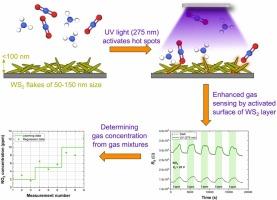通过墨水印刷 WS2 层实现紫外光激活的混合气体传感
IF 8
1区 化学
Q1 CHEMISTRY, ANALYTICAL
引用次数: 0
摘要
我们用油墨印刷的 WS2 薄片制作了一个传感层,并将其用于紫外线激活的气体传感。通过对重复印刷的结构进行光学成像,我们发现了由亚微米薄片组成的连续层,小面积原子力显微镜图像(1×1 µm2)也证实了这一点。通过使用偏振探测针头对表面进行原子力显微镜扫描,对传感表面的局部活性进行了研究。结果表明,紫外光放大了黑暗中现有的导电路径。这些热点与 WS2 表面的传感活性有关(局部吸附-解吸中心)。气体传感实验表明,随着二氧化氮和氮氧化物浓度的增加,WS2 传感器的直流电阻会发生反向变化,这与这些物质的电子接受和电子捐赠特性有关。相反,低频噪声在这两种气体中逐渐增强,而且在所有研究浓度下,噪声响应的相对变化都高于直流电阻响应。二氧化氮的直流电阻响应最低检测限为 103 ppb,而 NH3 的噪声响应最低检测限为 168 ppb。对上述目标气体混合物传感响应的研究表明,电阻波动的幅度并不是纯化合物光谱的直接总和。在混合气体中观察到的这种效应表明,这两种气体在吸附到传感表面或吸附中心之前发生的间歇性反应影响了它们的检测。本文章由计算机程序翻译,如有差异,请以英文原文为准。

UV light-activated gas mixture sensing by ink-printed WS2 layer
We fabricated a sensing layer from ink-printed WS2 flakes and utilized it for UV-activated gas sensing. The optical imaging of the structure made by repeated printing revealed the continuous layer comprising sub-µm flakes, confirmed independently by small-area AFM images (1×1 µm2). The activity of the sensing surface was investigated locally via AFM scanning of the surface with a polarized probing tip. The results indicated that the applied UV light amplifies the existing conducting paths in the dark. These hot spots are associated with the sensing activity of the WS2 surface (local adsorption-desorption centers). Gas sensing experiments revealed that the DC resistance of the WS2 sensor changes in the opposite direction for increasing concentrations of NO2 and NH3, which correlates with the electron-accepting and electron-donating properties of these species. On the contrary, low-frequency noise intensifies gradually in both gases, and relative changes in noise responses are higher than DC resistance responses for all investigated concentrations. The lowest detection limit obtained was 103 ppb from DC responses for NO2 and 168 ppb from noise responses for NH3. The studies of sensing responses for mixtures of the mentioned target gases revealed that the amplitude of resistance fluctuations is not a direct summation of spectra obtained for pure compounds. Such an effect observed for mixed gases indicates that the intermittent reactions between both species before adsorbing at the sensing surface or in the adsorption centers impact their detection.
求助全文
通过发布文献求助,成功后即可免费获取论文全文。
去求助
来源期刊

Sensors and Actuators B: Chemical
工程技术-电化学
CiteScore
14.60
自引率
11.90%
发文量
1776
审稿时长
3.2 months
期刊介绍:
Sensors & Actuators, B: Chemical is an international journal focused on the research and development of chemical transducers. It covers chemical sensors and biosensors, chemical actuators, and analytical microsystems. The journal is interdisciplinary, aiming to publish original works showcasing substantial advancements beyond the current state of the art in these fields, with practical applicability to solving meaningful analytical problems. Review articles are accepted by invitation from an Editor of the journal.
 求助内容:
求助内容: 应助结果提醒方式:
应助结果提醒方式:


